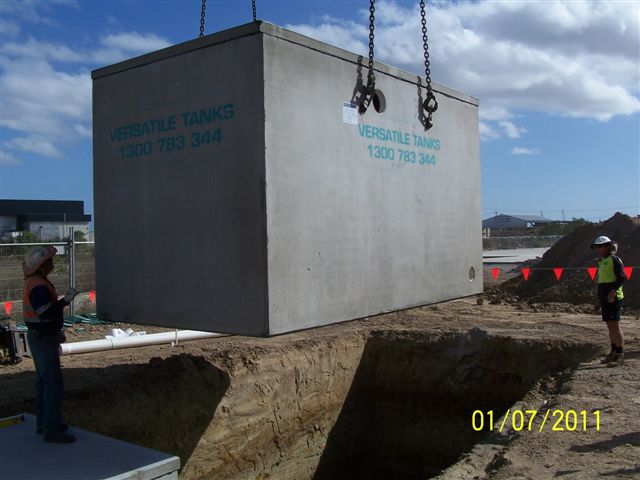**Please note Versatile Tanks DO NOT repair water tanks**
How to control porosity and reduce permeability and make a “watertight” concrete tank.
Premeability and concrete density go hand in hand. Ie for example Versatile Tanks are made using HSC (high strength concrete) 50mpa iinfiltration through HSC is very slow, in comparison to many round tanks that choose 25-32mpa the infiltration would be a lot faster. Rule of thumb, the higher the concrete density the more water tight the concrete becomes.
 Crane lowering a 22500 a concrete tanks underground.
Crane lowering a 22500 a concrete tanks underground.
Permeability is the measure of the ease with which fluids can flow through a porous material. It is expressed in speed. (mm/second)
To control porosity and reduce permeability and make a “watertight” concrete tank, it’s important to follow some of these “Watertightness Rules”:
- Water cement ratio (W/C) is the most important factor in concrete design. The water content in a mix controls the moisture’s rate of entry and the movement of water during the freeze-thaw process. The more excess water in a mix, the lower the strength, durability and watertightness. Excess mix water results in capillary pores – entrapped air pockets in hardened concrete that will reduce its resistance to leakage. On the other hand, too little water can cause placement difficulties and undesirable effects such as honeycombing. Hence a high probability your concrete will leak.
- The use of supplementary cementitious materials such as fly ash, slag and silica fume can also increase concrete’s density, thus reducing capillary porosity and permeability.
- Use well graded aggregates. Rounded coarse aggregates are preferred. It is important here when calculating water cement ratio to take into consideration moisture in your aggregates.
- Quality concrete manufacturing processes are critical to the production of durable, watertight concrete tanks. Proper attention to important pre-pour activities such as maintaining prescribed mix proportions, form cleanliness, and specified reinforcement placement and minimum cover is very important. Adequate consolidation of freshly placed concrete is an extremely important factor to produce a high-quality, dense concrete requires a higher compactive effort i.e. vibration of concrete to ensure adequate coverage of steel reinforcing. Higher cement content improves watertightness. Defect-free surfaces produced by using smooth forms and appropriate release agents can considerably improve the impermeability of a precast concrete product. Concrete must be adequately cured if its optimum properties are to be developed. An adequate supply of moisture, either by covering or other means, is important to ensure full hydration and reduce the porosity level such that the desired durability is attained.
- Execute joints and penetrations carefully. A system is only as strong as its weakest link. Close attention to all jointed, connected and sealed areas is absolutely necessary to ensure watertightness.
Many thanks to the Concrete Precast Association for all their assistance and valuable available information.
